Model 2: Difference between revisions
TheCamWheel (talk | contribs) mNo edit summary |
m (Several punctuation and grammatical revisions were made to make it easier to read. No information was added or omitted.) |
||
| (10 intermediate revisions by 4 users not shown) | |||
| Line 1: | Line 1: | ||
{{Infobox siren | {{Infobox siren|company=<div>Federal Electric | ||
| | <div>Federal Enterprises | ||
|image = | <div>Federal Sign & Signal</div> | ||
|caption = | <div>Federal Signal</div>|produced=1929-Present|image=Federal Signal Model 2.png|caption=A Federal Signal Model 2, located in Chesnee, SC. It uses the current revision of the housing. Photo by TrainsandSirens1.|output=100-102 dB @ 100 ft|type=Omnidirectional Electromechanical|hp=2 hp|voltage=120/240|current=AC/DC 1 ph|manual=http://www.civildefensemuseum.com/sirens/manuals/2-5-SD10-STH10-STL10-255A154F.pdf|preceded=[[Federal Electric Type Mach. B]]|title=Federal Signal Model 2|sheet=https://wiki.thesirenboard.com/images/e/e2/ANS312_2_0717.pdf}}The '''Model 2''' is a small 2-horsepower siren that has been produced by Federal Signal and its predecessors since 1929 and is the cheapest purpose-built outdoor warning siren on Federal's current lineup, as well as one of the longest-produced sirens in the world. Over the 90+ years the siren has been produced, it has gained a reputation as the fire siren of choice for many fire stations across the world. It is related to Federal Signal's [[Federal Signal Model 5|Model 5]] and its various sub-models. | ||
| | |||
|type = | |||
| | |||
| | |||
|preceded = [[ | |||
| | |||
|sheet= https://wiki.thesirenboard.com/images/e/e2/ANS312_2_0717.pdf | |||
}} | |||
The '''Model 2''' is | |||
== | == History == | ||
[[File:1 03ab89640c8d99ac3f12bea14a603fad 29.png|thumb|160x160px|A privately owned Fedelcode Type Mach. 2 on the ground.|left]] | |||
The Model 2 was originally introduced by Federal Electric in 1929 as the Federal Electric [[Federal Electric Fedelcode|Fedelcode]] Type Mach. 2, with the earliest Type Mach. 2 units using a housing that looked similar to later Fedelcode sirens. This was then switched to a 3-louvered design, with 2 louvres on top, and 1 on the bottom. These sirens were much taller than modern Model 2s, using a "long-legged" design with taller mounting legs. These units lacked an intake cone, so they weren't as effective as later models. Additionally, the motors of this generation had 4 brushes instead of 2, which are used today.[[File:Fedelcode No. 2 Code Siren.png|thumb|160px|A No. 2 Fedelcode Code Siren as advertised by Federal Electric.|left]] | |||
[[File:Later Enterprises Model 2 new.jpg|thumb|158x158px|A later Federal Enterprises Model 2 with the redesigned housing, located in Milwaukee, WI. It is inactive.]]The Fedelcode Type Mach. 2 could optionally come with a coding mechanism allowing it to make a pulse signal, and these units were dubbed the "'''No. 2 Fedelcode Code Siren'''". Coded signals were achieved using a rotating coding ring on the stator, instead of a damper. This ring was gear-driven by a separate smaller motor, and this would rotate a second stator to block the stator ports, nearly silencing the siren instantly. When the motor was de-energized, the second stator would move back out of the way, allowing the siren to immediately return to full output. Due to the speed of mechanism, the coding on this siren was fast enough that it was claimed to be capable of creating Morse code signals, something that damper-equipped sirens are unable to do. Federal Electric units were identical to the Fedelcode units, except for lacking the coding option and having the "FEDERAL" badge instead of "FEDELCODE" on the housing. | |||
In 1948, when Federal Electric became Federal Enterprises, the Fedelcode Type Mach. 2 was slightly redesigned with a small, rounded nub on top of the housing but was otherwise identical to a Fedelcode Type Mach. 2. The coding mechanism would also be discontinued, and the Fedelcode name was dropped in favor of the Federal Enterprises name, thus, the "FEDELCODE" and "FEDERAL" badges were discontinued. The siren would also be renamed simply to the "Model 2." The siren would then see another, more compact redesign sometime in the early 1950s, when the siren was revamped with much shorter legs and evenly spaced louvers, and an intake cone added to improve the siren's performance. Both of these designs were short-lived, being produced for only a few years each, which makes these the least common Model 2 designs. [[File:Early Enterprises Model 2.png|thumb|159x159px|A freshly restored early Federal Enterprises Model 2.|left]] | |||
[[File: | |||
The Model 2's chopper and motor were used in Federal's popular [[Federal Signal Thunderbolt|Thunderbolt]] series that were produced between 1952 and 1990, with the Thunderbolt 1000 essentially being a rotational supercharged Model 2. Early Thunderbolt 1000Ts made use of the 2T's 4/5-port rotor, though the Thunderbolt 1000T would eventually use its unique 5/6-port rotor. The Model 2's design was changed again to its modern current version when Federal Enterprises became Federal Sign & Signal in 1955, featuring a new shroud with 1 louver on top, and 2 on the bottom. This version of the Model 2 continues to be sold to this day and has remained largely unchanged since then, besides the tag placement. | |||
[[ | |||
Over 90 years after its introduction, the Model 2 is still in production to this day. Due to its great perfomance at its small size, easy power requirements, ease of maintenance, and low cost, the Model 2 is easily the most common siren in the United States and Canada, where it finds use as a fire siren for many fire departments. Federal's partnerships with manufacturers such as GCS and [[W.S. Darley & Co.|W.S. Darley & Co]]. further contributed to the Model 2's popularity as well. The siren can also commonly be found in chemical, oil, and industrial plants, where they serve as an emergency siren or lunch whistle. It competes today with other small electric sirens such as the [[Sentry Siren|Sentry]] [[Sentry 3V8|3V8]], Federal's own [[Federal Signal Model ECLIPSE|Model ECLISPE<sup>8</sup>]], and the ASC [[ASC Tempest|T-112]], among others. | |||
== Design == | |||
The Model 2 is a small, simple vertical siren, using a 2 hp universal motor to drive a small, 5-port single-tone chopper at 6,000-8500 rpm, which allows the siren to reach roughly 102 dB at 100 ft. The Model 2 is available in two power configurations, the 120 V Model 2-120, or the 240 V Model 2-240. Model 2 sirens are AC/DC because of the universal motor, able to run on either 1 ph AC or high voltage DC. The siren is not available in 3 ph models. The rotor on the Model 2 is open on both the top and bottom, which allows the siren to intake on either side of the rotor to maximize airflow through the chopper. This is also what allowed the siren to be later repurposed as the [[Federal Signal Thunderbolt|Thunderbolt 1000]], as air can pass through the motor, unlike sirens with single-sided rotors. The housing itself is compact and efficient, projecting both the sound from the rotor, as well as the intake evenly in all directions with little wasted output. Due to the use of a universal motor, the Model 2 has a logarithmic windup, and a rapid winddown. The Model 2 is designed for use at fire stations and other areas where long-range coverage isn't needed, such as coverage gaps in a larger system, as well as for industrial use where a smaller industrial siren such as the [[Federal Signal Model A|Model A]] or [[Federal Signal Model L|Model L]] wouldn't cut it. The Model 2, along with the rest of the [[Federal Signal Model 5|Model 5s]] (then known as the [[Federal Electric Fedelcode|Fedelcode]] series) was intended to replace the antiquated [[Federal Electric Type Mach. B|Type Mach. B]], which was lacking in performance and being outsold by its competitors such as the [[Sterling Siren Fire Alarm Co.|Sterling]] [[Sterling Model M|Model M]]. The Model 2 matches the Type Mach. B in performance, while being much smaller, less expensive to produce, easier to install and maintain, and far more weatherproof. The two sirens were produced at the same time for a short time before the Type B was discontinued in the 1930s. | |||
=== Variants === | |||
==== Model 2T(T) ==== | |||
[[File:Model 2T new.jpg|thumb|159x159px|A Model 2T without its shroud, using the modern Model 2 design.]] | |||
A dual-tone variant of the standard Model 2 was introduced in the late 1940s/early 1950s as a dual-tone option of the standard Model 2, named the '''Model 2T''' (or '''Type 2TT''' for units built during the FS&S era; Enterprises units are simply marked as Type 2). The siren was primarily intended for civil defense purposes during the Cold War. The Model 2T used a 4/5 port dual tone chopper and stator instead of the 5-port the normal 2 used, though this resulted in the siren only being able to produce 100 dB at 100 ft due to noise cancellation from the sounds clashing, as well as the shorter height of each port. The Model 2T shares the same rotor as the 4/5-port variant of the Thunderbolt 1000T built between 1954 and 1959. The Model 2T was otherwise entirely identical to a standard Model 2, and came in both the "long-legged" and standard variants. The Model 2T was discontinued sometime around 1981 for unknown reasons, leaving the standard single-tone Model 2 as the only available version. Due to its shorter production run, Model 2Ts are much harder to find than standard 2s. Model 2Ts were often painted civil defense yellow, which can help identify suspected 2Ts, although this is not always accurate. | |||
==== Model 2-3Z (Canadian Model 2) ==== | |||
[[File:Canadian Model 2.png|thumb|160x160px|An earlier Canadian Model 2, showing both the housing and the siren itself. The motor cover would be integrated with the housing on later units.|left]] | |||
Federal Signal also had a variant of the Model 2 that was designed specifically for the Canadian market and is essentially a Model 2s core flipped upside down. This variant is marked on the tag as "'''Model 2-3Z'''", although Federal also refers to them as "'''Canadian Model 2'''" in the manual. With these modes, the motor is located on top of the rotor, with the intake being located between the mounting legs. Model 2-3Zs lack an intake cone due to a lack of space between the mounting legs. The motor itself is surrounded by a cylindrical cover, which shields it from the elements. On earlier models, the cover was attached to the siren itself and was separate from the housing, but this was changed on later models to integrate the motor cover with the housing itself, likely to reduce the cost of production. [[File:Model 2-3Z.png|thumb|157x157px|A privately owned 1986 Model 2-3Z, owned by Sirens & Thunderbolts 1003. His [[Sterling Siren Fire Alarm Co.|Sterling]] [[Sterling Vertical Siren|Model 2V8]] is visible.]] | |||
These changes were meant to protect the siren from the harsh cold and snow of Canadian winters and improve the siren's durability. The rotor, motor, and stator are all identical to a standard Model 2. A common misconception is that these sirens run at a lower pitch than standard Model 2s; this is usually due to the brushes wearing out, or the siren being underpowered, as many of these are 240V models running on 120V. The housing resembles Fedelcode era Model 2s with the skirt placement, although they are significantly shorter in height, with the bottom section being much shorter. Many also have the nub on the top of the housing shared with early standard Federal Enterprises units. Model 2-3Zs are by far the most common fire sirens in Canada, though lack of maintenance has led to many units dying or wearing out as the brushes age. | |||
It can be assumed that these began production around the same time as Fedelcode era Model 2s, although these appear to have been produced as late as 1986 with minimal design changes. Little documentation exists from Federal Signal about these sirens beyond the manual. Interestingly, the manual depicts the siren with a standard Model 2 housing despite all Model 2-3Zs using their special housing. The Model 2-3Z is no longer in production today, being eliminated from Federal's lineup no further than the late 1990s and effectively replaced by the standard Model 2. | |||
[[Category:Federal Signal Corporation]][[Category:Electromechanical Sirens]][[Category:Omnidirectional Sirens]][[Category:Single Toned Sirens]][[Category:Sirens]][[Category:Dual Toned Sirens]] | [[Category:Federal Signal Corporation]][[Category:Electromechanical Sirens]][[Category:Omnidirectional Sirens]][[Category:Single Toned Sirens]][[Category:Sirens]][[Category:Dual Toned Sirens]] | ||
Latest revision as of 14:52, 25 November 2024
| Federal Signal Model 2 | |
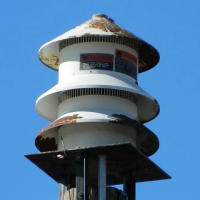 A Federal Signal Model 2, located in Chesnee, SC. It uses the current revision of the housing. Photo by TrainsandSirens1. | |
| Company | Federal Electric
Federal Enterprises
Federal Sign & Signal
Federal Signal
|
|---|---|
| Produced | 1929-Present |
| Type | Omnidirectional Electromechanical |
| Sound output | 100-102 dB @ 100 ft |
| Horsepower | 2 hp |
| Voltage | 120/240 V AC/DC 1 ph |
| Preceded by | Federal Electric Type Mach. B |
| Documentation | Manual Product sheet |
The Model 2 is a small 2-horsepower siren that has been produced by Federal Signal and its predecessors since 1929 and is the cheapest purpose-built outdoor warning siren on Federal's current lineup, as well as one of the longest-produced sirens in the world. Over the 90+ years the siren has been produced, it has gained a reputation as the fire siren of choice for many fire stations across the world. It is related to Federal Signal's Model 5 and its various sub-models.
History
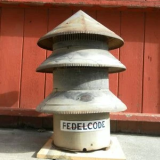
The Model 2 was originally introduced by Federal Electric in 1929 as the Federal Electric Fedelcode Type Mach. 2, with the earliest Type Mach. 2 units using a housing that looked similar to later Fedelcode sirens. This was then switched to a 3-louvered design, with 2 louvres on top, and 1 on the bottom. These sirens were much taller than modern Model 2s, using a "long-legged" design with taller mounting legs. These units lacked an intake cone, so they weren't as effective as later models. Additionally, the motors of this generation had 4 brushes instead of 2, which are used today.
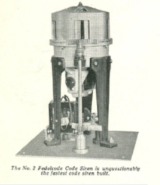
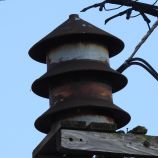
The Fedelcode Type Mach. 2 could optionally come with a coding mechanism allowing it to make a pulse signal, and these units were dubbed the "No. 2 Fedelcode Code Siren". Coded signals were achieved using a rotating coding ring on the stator, instead of a damper. This ring was gear-driven by a separate smaller motor, and this would rotate a second stator to block the stator ports, nearly silencing the siren instantly. When the motor was de-energized, the second stator would move back out of the way, allowing the siren to immediately return to full output. Due to the speed of mechanism, the coding on this siren was fast enough that it was claimed to be capable of creating Morse code signals, something that damper-equipped sirens are unable to do. Federal Electric units were identical to the Fedelcode units, except for lacking the coding option and having the "FEDERAL" badge instead of "FEDELCODE" on the housing. In 1948, when Federal Electric became Federal Enterprises, the Fedelcode Type Mach. 2 was slightly redesigned with a small, rounded nub on top of the housing but was otherwise identical to a Fedelcode Type Mach. 2. The coding mechanism would also be discontinued, and the Fedelcode name was dropped in favor of the Federal Enterprises name, thus, the "FEDELCODE" and "FEDERAL" badges were discontinued. The siren would also be renamed simply to the "Model 2." The siren would then see another, more compact redesign sometime in the early 1950s, when the siren was revamped with much shorter legs and evenly spaced louvers, and an intake cone added to improve the siren's performance. Both of these designs were short-lived, being produced for only a few years each, which makes these the least common Model 2 designs.
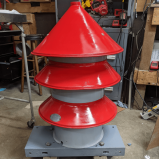
The Model 2's chopper and motor were used in Federal's popular Thunderbolt series that were produced between 1952 and 1990, with the Thunderbolt 1000 essentially being a rotational supercharged Model 2. Early Thunderbolt 1000Ts made use of the 2T's 4/5-port rotor, though the Thunderbolt 1000T would eventually use its unique 5/6-port rotor. The Model 2's design was changed again to its modern current version when Federal Enterprises became Federal Sign & Signal in 1955, featuring a new shroud with 1 louver on top, and 2 on the bottom. This version of the Model 2 continues to be sold to this day and has remained largely unchanged since then, besides the tag placement.
Over 90 years after its introduction, the Model 2 is still in production to this day. Due to its great perfomance at its small size, easy power requirements, ease of maintenance, and low cost, the Model 2 is easily the most common siren in the United States and Canada, where it finds use as a fire siren for many fire departments. Federal's partnerships with manufacturers such as GCS and W.S. Darley & Co. further contributed to the Model 2's popularity as well. The siren can also commonly be found in chemical, oil, and industrial plants, where they serve as an emergency siren or lunch whistle. It competes today with other small electric sirens such as the Sentry 3V8, Federal's own Model ECLISPE8, and the ASC T-112, among others.
Design
The Model 2 is a small, simple vertical siren, using a 2 hp universal motor to drive a small, 5-port single-tone chopper at 6,000-8500 rpm, which allows the siren to reach roughly 102 dB at 100 ft. The Model 2 is available in two power configurations, the 120 V Model 2-120, or the 240 V Model 2-240. Model 2 sirens are AC/DC because of the universal motor, able to run on either 1 ph AC or high voltage DC. The siren is not available in 3 ph models. The rotor on the Model 2 is open on both the top and bottom, which allows the siren to intake on either side of the rotor to maximize airflow through the chopper. This is also what allowed the siren to be later repurposed as the Thunderbolt 1000, as air can pass through the motor, unlike sirens with single-sided rotors. The housing itself is compact and efficient, projecting both the sound from the rotor, as well as the intake evenly in all directions with little wasted output. Due to the use of a universal motor, the Model 2 has a logarithmic windup, and a rapid winddown. The Model 2 is designed for use at fire stations and other areas where long-range coverage isn't needed, such as coverage gaps in a larger system, as well as for industrial use where a smaller industrial siren such as the Model A or Model L wouldn't cut it. The Model 2, along with the rest of the Model 5s (then known as the Fedelcode series) was intended to replace the antiquated Type Mach. B, which was lacking in performance and being outsold by its competitors such as the Sterling Model M. The Model 2 matches the Type Mach. B in performance, while being much smaller, less expensive to produce, easier to install and maintain, and far more weatherproof. The two sirens were produced at the same time for a short time before the Type B was discontinued in the 1930s.
Variants
Model 2T(T)
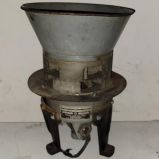
A dual-tone variant of the standard Model 2 was introduced in the late 1940s/early 1950s as a dual-tone option of the standard Model 2, named the Model 2T (or Type 2TT for units built during the FS&S era; Enterprises units are simply marked as Type 2). The siren was primarily intended for civil defense purposes during the Cold War. The Model 2T used a 4/5 port dual tone chopper and stator instead of the 5-port the normal 2 used, though this resulted in the siren only being able to produce 100 dB at 100 ft due to noise cancellation from the sounds clashing, as well as the shorter height of each port. The Model 2T shares the same rotor as the 4/5-port variant of the Thunderbolt 1000T built between 1954 and 1959. The Model 2T was otherwise entirely identical to a standard Model 2, and came in both the "long-legged" and standard variants. The Model 2T was discontinued sometime around 1981 for unknown reasons, leaving the standard single-tone Model 2 as the only available version. Due to its shorter production run, Model 2Ts are much harder to find than standard 2s. Model 2Ts were often painted civil defense yellow, which can help identify suspected 2Ts, although this is not always accurate.
Model 2-3Z (Canadian Model 2)

Federal Signal also had a variant of the Model 2 that was designed specifically for the Canadian market and is essentially a Model 2s core flipped upside down. This variant is marked on the tag as "Model 2-3Z", although Federal also refers to them as "Canadian Model 2" in the manual. With these modes, the motor is located on top of the rotor, with the intake being located between the mounting legs. Model 2-3Zs lack an intake cone due to a lack of space between the mounting legs. The motor itself is surrounded by a cylindrical cover, which shields it from the elements. On earlier models, the cover was attached to the siren itself and was separate from the housing, but this was changed on later models to integrate the motor cover with the housing itself, likely to reduce the cost of production.
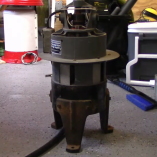
These changes were meant to protect the siren from the harsh cold and snow of Canadian winters and improve the siren's durability. The rotor, motor, and stator are all identical to a standard Model 2. A common misconception is that these sirens run at a lower pitch than standard Model 2s; this is usually due to the brushes wearing out, or the siren being underpowered, as many of these are 240V models running on 120V. The housing resembles Fedelcode era Model 2s with the skirt placement, although they are significantly shorter in height, with the bottom section being much shorter. Many also have the nub on the top of the housing shared with early standard Federal Enterprises units. Model 2-3Zs are by far the most common fire sirens in Canada, though lack of maintenance has led to many units dying or wearing out as the brushes age.
It can be assumed that these began production around the same time as Fedelcode era Model 2s, although these appear to have been produced as late as 1986 with minimal design changes. Little documentation exists from Federal Signal about these sirens beyond the manual. Interestingly, the manual depicts the siren with a standard Model 2 housing despite all Model 2-3Zs using their special housing. The Model 2-3Z is no longer in production today, being eliminated from Federal's lineup no further than the late 1990s and effectively replaced by the standard Model 2.